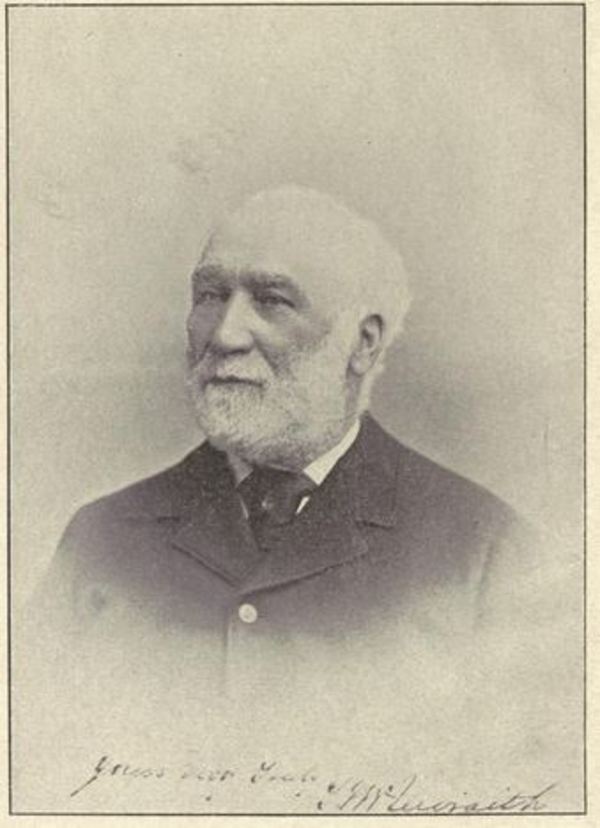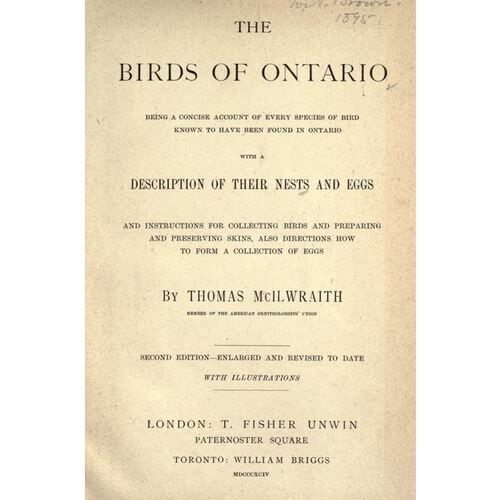
Source: Link
McILWRAITH, THOMAS, businessman and ornithologist; b. 26 Dec. 1824 in Newton upon Ayr, Scotland, seventh of the ten children of Thomas McIlwraith, a weaver, and Jean Adair Forsyth; m. there 20 Oct. 1853 Mary Park, and they had four daughters, one of whom died in infancy, and four sons; d. 31 Jan. 1903 in Hamilton, Ont.
Thomas McIlwraith pursued a double career, his work in public utilities and trade set against a lifelong devotion to natural history. He was apprenticed in Scotland as a cabinet-maker, but by 1851 was manager of the Newton Gas Works. He emigrated to Hamilton, Upper Canada, late in 1853 to fill a similar position. His business career was not outstanding, although he was well connected with the Scottish élite in a city where fortunes were to be made by aggressive entrepreneurs. In 1871, after 18 years as manager of the Hamilton Gas Light Company, he resigned and bought what would be known as the Commercial Wharf, at the foot of MacNab Street. His company imported coal and forwarded industrial products. Its wagons were a familiar sight on city streets, but lack of access to railways and a focus on such imports as pig-iron, being superseded by domestic products, eventually undermined the business, and it was sold soon after his death.
McIlwraith held positions on the boards of various local banks and insurance companies, and in 1878 he sat on Hamilton City Council. He seems not to have been deeply involved in any of these, however, and largely withdrew from the business community during the 1880s. He was an active member of Central Presbyterian Church, and voted Liberal.
McIlwraith is chiefly remembered as a pioneer ornithologist. A field man, he believed strongly that direct observation was essential to understanding habitat and migration, two aspects of ornithology that particularly intrigued him. With his brother Andrew and later with his youngest son, Kennedy Crawford, he walked almost daily for miles along Burlington Bay (Hamilton Harbour), Dundas Marsh, and the “mountain.” One must suppose that the routine at the gasworks was a tedious imposition upon his true interests, and that a desire to devote more time to the study of birds influenced his move to private business.
Shooting, skinning, and mounting stuffed birds for display and study was common in the 19th century before cameras and binoculars became available, and McIlwraith regularly went “gunning” for species to add to his collection. Killing birds for study seems not to have borne heavily on the consciences of his generation. He did his own taxidermy, and hundreds of his specimens, some in the wooden cases McIlwraith himself made, may still be studied at Hamilton’s Royal Botanical Gardens Nature Interpretive Centre and at the Royal Ontario Museum in Toronto. The renowned naturalist Ernest Thompson Seton* learned taxidermy from him and borrowed models for drawing. Between 1883 and 1896 McIlwraith traded bird skins with collectors throughout North America.
McIlwraith became widely recognized for his contributions to Canadian science. He was vice-president of the Hamilton Association for the Advancement of Literature, Science, and Art in 1860, served as its librarian and curator for 15 years, and was elected president in 1880; he also presided for several years over the local mechanics’ institute. In 1883 he was invited, along with William Edwin Saunders and Montague Chamberlain*, to serve as a founding member of the American Ornithologists’ Union in New York, the only Canadians so honoured in a group of 23. The union then appointed McIlwraith coordinator of bird migration records for Ontario, establishing him as the province’s foremost ornithologist. The records he had been collecting since 1856 culminated in the publication in 1886 of Birds of Ontario. A landmark in the maturing of avian biology as a discipline, it included 302 species observed within a six-mile radius of Hamilton city limits. The study received international recognition as a model of its kind. McIlwraith’s prose is entertaining and is infused with an eloquent sensitivity to the joys of nature study. The public lectures he gave on ornithology were popular, and he had an engaging sense of humour.
About 1890 McIlwraith and John Macoun* of the Geological Survey of Canada undertook to write a bird book for the whole country; Macoun was to contribute his continent-wide field experience and McIlwraith was to do the writing. To their disappointment, however, the survey cancelled the project two years later. McIlwraith’s lack of formal education (previously not an impediment), or the fact that he did not belong to the survey’s inner circle, may have influenced the decision. He turned his business over to his son Thomas Forsyth in 1893 and undertook to revise Birds of Ontario, which appeared in an expanded and illustrated edition the following year. He then retired to dote upon his gardens and fruit-trees.
[A number of important sources for Thomas McIlwraith remain in the possession of his descendants, including a family bible and a diary kept by his brother Andrew from 1857 to 1862. Of particular value in detailing McIlwraith’s commercial activities is the family’s collection of several hundred business postcards dating from the 1870s to the 1890s, which identify his network of business contacts. The collection is discussed in Diana Middleton and D. F. Walker, “Thomas McIlwraith: Hamilton coal merchant and forwarder, 1871–1893” (typescript, Univ. of Waterloo, Ont., 1980; copy in the author’s possession). It also includes about 100 postcards, dated 1883–96, concerning McIlwraith’s role as recorder of migration patterns for the American Ornithologists’ Union (AOU), and his trade in bird skins with other collectors across North America.
Six letters written by McIlwraith in 1885 to Joel Asaph Allen of Cambridge, Mass., concerning the publication of Birds of Ontario, are held by the NA (MG 29, B34). The Ornithology Dept. of the Royal Ontario Museum (Toronto) holds a 29-page manuscript “Catalogue of birds” (1891); and correspondence from McIlwraith is available in the Div. of Birds papers in the Smithsonian Institution Arch. (Washington).
Thomas McIlwraith’s main publication, The birds of Ontario, being a list of birds observed in the province . . . was published at Hamilton, Ont., in 1886; the enlarged second edition, which also added engraved illustrations by an uncredited artist, was issued at Toronto in 1894 under the title The birds of Ontario, being a concise account of every species of bird known to have been found in Ontario. . . . He also produced several articles on ornithology, including “List of birds observed in the vicinity of Hamilton, C.W., arranged after the system of Audubon” and “Notices of birds observed near Hamilton, C.W.,” both in the Canadian Journal (Toronto), new ser., 5 (1860): 387–96, and 6 (1861): 6–18, 129–38; “List of birds observed near Hamilton, C.W.,” Essex Institute, Proc. (Salem, Mass.), 5 (1866): 79–96; and two articles in the Hamilton Spectator, 21 Jan. 1882 and 24 Feb. 1896 (the latter, on the pine grosbeak, is the last published piece by McIlwraith which this author has located). t.f.mci.]
GRO-E, Newton upon Ayr, marriage certificate, 20 Oct. 1853; reg. of births and baptisms. HPL, Clipping file, Hamilton biog.; Hamilton city records, RG 1, 1854–72; Scrapbooks, Richard Butler, “Saturday musings”; H. F. Gardiner; H. B. Witton. NA, RG 31, C1, 1861, 1871, Hamilton. Hamilton Spectator, 2 Feb. 1903. “Life of Thomas McIlwraith is worthy of study,” Hamilton Spectator, 5 Oct. 1946: 12 [No author is named, but the article appears to have been prepared by James Little Baillie, Percy Parker Ghent, and Thomas Forsyth McIlwraith (a grandson of the subject), all connected with the Royal Ontario Museum. It is informative, and dips well below the surface skimmed by other reviews of McIlwraith’s life. t.f.mci.] American Ornithologists’ Union, Fifty years’ progress of American ornithology, 1883–1933 (rev. ed., Lancaster, Pa, 1933). Auk: a Quarterly Journal of Ornithology (Cambridge, Mass.), 20 (1903): 242 (obit. note by the editor, [J. A. Allen]); 21 (1904): 1–7 (obit. article by A. K. Fisher). Canadian men and women of the time (Morgan; 1898). DHB [The McIlwraith entry is badly flawed, although its author seems to have seen the 1946 Hamilton Spectator article. t.f.mci.]. Marianne Gosztonyi Ainley, “Canadian involvement in the AOU,” in K. B. Sterling and Marianne Gosztonyi Ainley, A centennial history of the AOU (forthcoming); “From natural history to avian biology: Canadian ornithology, 1860–1950” (phd thesis, McGill Univ., Montreal, 1985), esp. 53–63. Hamilton Assoc. for the Advancement of Lit., Science and Art, Proceedings of the jubilee celebration . . . 1857–1907 (Hamilton, 1907); 75th anniversary meeting . . . 1857–1932 (Hamilton, 1932), 16. W. A. Waiser, The field naturalist: John Macoun, the Geological Survey, and natural science (Toronto, 1989).
Cite This Article
Thomas F. McIlwraith, “McILWRAITH, THOMAS,” in Dictionary of Canadian Biography, vol. 13, University of Toronto/Université Laval, 2003–, accessed December 19, 2025, https://www.biographi.ca/en/bio/mcilwraith_thomas_13E.html.
The citation above shows the format for footnotes and endnotes according to the Chicago manual of style (16th edition). Information to be used in other citation formats:
| Permalink: | https://www.biographi.ca/en/bio/mcilwraith_thomas_13E.html |
| Author of Article: | Thomas F. McIlwraith |
| Title of Article: | McILWRAITH, THOMAS |
| Publication Name: | Dictionary of Canadian Biography, vol. 13 |
| Publisher: | University of Toronto/Université Laval |
| Year of publication: | 1994 |
| Year of revision: | 1994 |
| Access Date: | December 19, 2025 |




